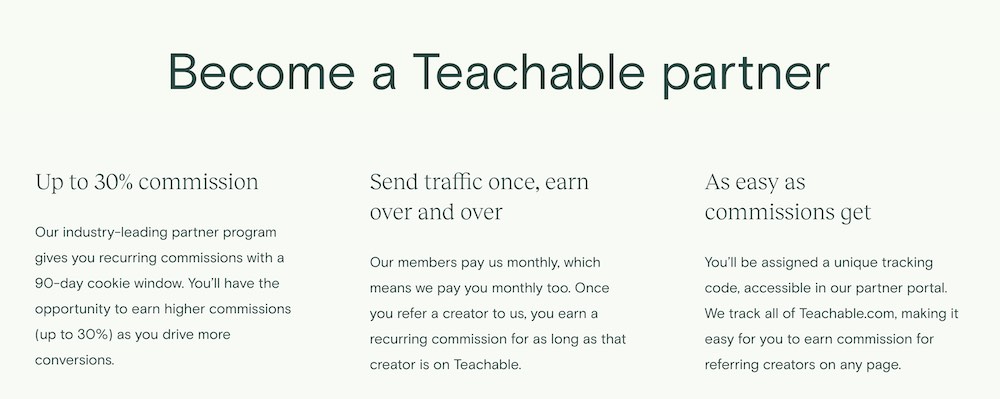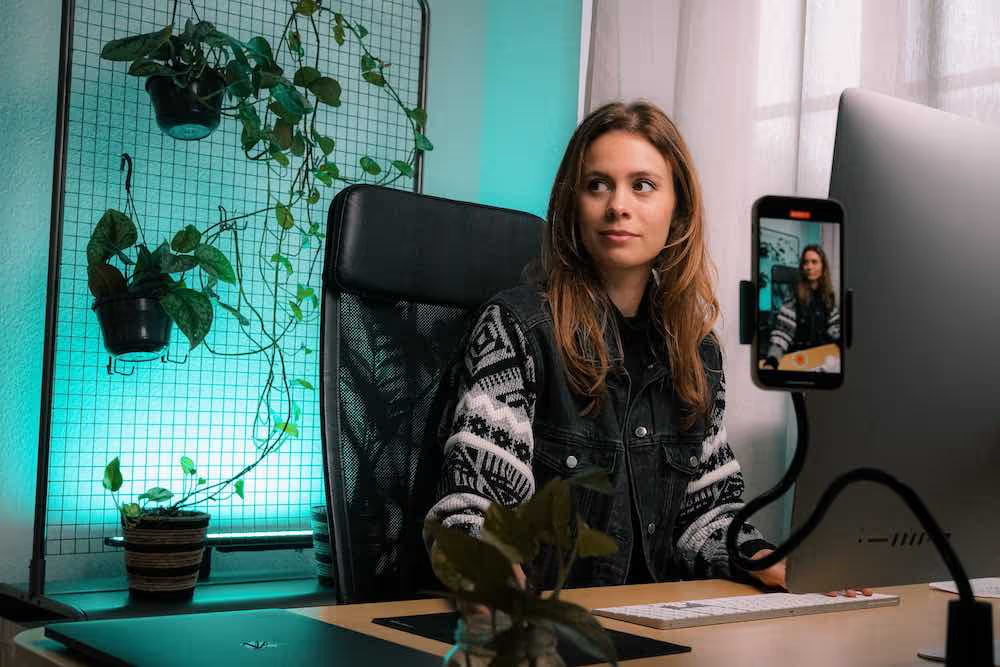As a content creator, you’ve probably asked how to get sponsored on YouTube. Many brands are partnering with creators to promote their products and services. In a 2022 survey, 74% of marketers said they plan to spend at least a quarter of their budgets on content creator partnerships.
In addition, another study found that marketers consider YouTube videos the second most effective channel for influencer marketing, right behind Instagram. Although, notably, the study didn’t include TikTok, which is rising in popularity.
Getting YouTube sponsorship is not as difficult as most people think. You can get sponsorship even with a small channel. Brands use micro-influencers 10 times more than the big influencers.
That said, there is also a lot of interest in making a living as a content creator. In addition, 22% of brands find it hard to get appropriate influencers. This guide on how to get sponsored on YouTube can help you land sponsorships and build a sustainable source of income online.
Types of YouTube sponsorships
There are three primary types of YouTube sponsorships that you can pursue—product review, affiliate, or paid brand sponsorships. Some are easier to attain than others. Here are the common types of YouTube sponsorships and how they work.
Product reviews
Smaller channels may not have the proof of concept or a large audience following to attract paid brand sponsorships. One of the easiest ways to work with brands when you are just starting out is to do product reviews.
A product review sponsorship is when a brand sends you a free product to test or try out on your channel. Brands with more expensive products may give you a discount on a product purchase in exchange for a product. These types of videos are how many successful YouTubers have gotten their start.
For example, Hyram, the skincare YouTuber started out doing product reviews. Now he has close to 5 million subscribers. He then went on to land more lucrative paid sponsorships with brands like The Inkey List and now has his own line of skincare products.

Product reviews are one of the most watched types of video, with unboxing and tutorial videos being some of the most popular.
You can get monetary compensation for product reviews if you have a subscriber base of over 10,000. However, typically, there is no monetary compensation aside from the free products.
Affiliate sponsorship
Affiliate sponsorships are an easy way to monetize your YouTube, especially for small channels. The brand you are promoting will give you a referral or affiliate link that you place in the description or your video or your channel.
You get a commission when your subscribers click on the link and make a purchase. Also, a brand may give you a unique discount code to share with your subscribers. When your audience makes a purchase and uses your code, you get a percent of the sale as commission.
You can promote the brand by reviewing the product or mentioning it in your videos. Affiliate sponsorships are one of the easiest ways to monetize YouTube, but the amount of money you earn varies by brand.
For example, makeup and fashion affiliate programs are common but not incredibly profitable. Many use LTK, also known as Liketoknow.it, or other shopping widgets that act as middlemen for brands like Walmart and Target and influencer affiliates. The commission percent ranges, but it usually hovers around 10%.
Since the cost of clothing tends to be on the lower end, your commission can be as low as a few cents or dollars on each purchase. However, those commissions add up, especially if you grow your following and have an engaged audience.
The other way to increase how much money you make through affiliate partnerships is to promote higher-ticket items or brands with higher commissions. SaaS companies tend to have commissions between 25% to 30%. For example, Teachable’s affiliates can earn up to 30% commission.

Paid sponsorship
Paid sponsorships, also known as exclusive brand deals, are the most lucrative type of the three. Sponsors typically pay you a flat fee to market their products or services on your channel.
Because paid sponsorships are the most profitable, they are also the most coveted and hardest to land. For instance, MrBeast has over 100 million subscribers and is estimated to make $11 million per year in brand partnerships alone. His total annual revenue from YouTube is closer to 50 million.
Related post: How to find brand collaborations as an influencer

That doesn’t mean that there aren’t opportunities for paid sponsorship for small YouTubers—it just might take a little more time and work to achieve.
If you have between 10,000 and 100,000 subscribers, it’s easier to get them. In addition, paid sponsorships tend to have more specific demands than affiliates or product reviews.
For instance, brands may ask to review how they will be featured in videos before they go live. One way to find these types is to use a sponsor network. These platforms connect creators to brands and are an excellent way to get paid sponsors when you are just growing. However, they also have requirements. Grapevine, for example, requires that you have 10,000 subscribers.
Whether you are doing a product review or another type of sponsorship, you should focus on brands that you’ve used or that match your niche. You’ll have more engagement if the products you promote are of interest to your subscribers. For instance, if you have a makeup channel, you should reach out to skincare brands.
How many subscribers do you need to get sponsored?
There is no one-size-fits-all regarding the number of subscribers you need to get sponsored. However, you can use the YouTube Partner Program (YPP) eligibility requirements as a guideline. The YPP is YouTube’s offering to help creators to monetize their videos.
One of the many ways that YouTubers make money is through ads. To get paid for ads on YouTube, creators need to have more than 1,000 subscribers and 4,000 hours of video watched in the last year.
In other words, you should have a minimum of 1,000 YouTube subscribers before reaching out to brands for sponsorship. However, it’ll be easier to land offers in other types of sponsorships when you have 10,000 or more.
How much do sponsors pay YouTubers?
The highest-paid YouTubers earn between $54 million and $16 million per year. However, they have well over 100 million subscribers and sponsorships are only a portion of their total income.
Your earning potential varies vastly depending on the size of your audience and their engagement. It also varies by the sponsor. SaaS companies tend to pay more, but not always. If the product costs more, then you might get paid more.
Here are the most influential factors that determine how much you can earn from a YouTube sponsor.
- Number of subscribers
- Video views and hours watched
- Audience engagement
- Type of sponsorship
An unspoken rule in the influencer world is that you can get paid $10 per 1,000 followers. In reality, it’s more of a suggestion and not a rule. It’s also a little more commonly applied to sponsored content on Instagram.
YouTube videos tend to require more work to create on your end. For YouTube, it’s more like $18 to $20 per 1,000 followers. If you have no idea how to set your prices, use this as a benchmark but adjust for your circumstances.
How to get sponsored on YouTube
YouTube has a creator marketplace called BrandConnect. It’s similar to Instagram and TikTok’s creator marketplace and is invite-only. It’s YouTube’s way of offering more brand deals and sponsorships on the platform, but again, it’s only available to a select few YouTubers.
For the most part, when it comes to how to get sponsored on YouTube, you’ll have to do a bit of leg work on your own.
These strategies for how to get sponsored on YouTube can help.
1. Do an audit of your YouTube channel
If you have already created your YouTube channel, and have been consistently creating content at least every week, the next step is an audit. When it comes to getting YouTube sponsorships, you have to put your best foot forward. A channel audit can help you do just that.
Here are a few elements that will make your YouTube channel look professional.
YouTube banner
The banner is the first thing that viewers see when they come to your YouTube channel. It is the header and contains the details of your brand, but it also tells a story. It may have:
- Your headshot
- Branding and partnerships
- Your name or channel name
- Video posting schedule
- A tagline
- Current content highlights
- A call to action
Try to keep the banner simple, with no more than three to five elements. Otherwise, it will feel busy.
For example, Miranda in the Wild is an REI-exclusive YouTube channel. Miranda films outdoor video content for REI. The YouTube channel has the branding of the company, an image of Miranda, and an illustration of the brand’s summer road trip series.

Video thumbnails
The thumbnail is the image that acts as a preview for your videos. A good thumbnail will make people want to watch your video. Search any of your favorite YouTube channels, and you’ll notice that they tend to have similar design principles.
They are simple but catch your attention. You should include the title of your video and a headshot or eye-catching image.
You can easily create a YouTube banner and thumbnail image with Canva. Go to the site and search “YouTube banner” or “YouTube thumbnail” and you’ll have thousands of templates to choose from and customize to your personal branding.

Channel trailer
The channel trailer is a short video that introduces viewers to you and your channel. It remains on the main page and introduces your visitors to the type of content you produce and how often you add new videos.
A good example of a channel trailer is femke.design, a product design YouTuber. She introduces herself, her experience, the type of content she creates, and more in under 40 seconds.

Playlists
You’ll also want to consider creating playlists to organize your content. A playlist is a collection of videos that appears as a bold title. Here is an example of a playlist from Noah Kagan.

Organizing your YouTube channel this way quickly tells sponsors—and viewers—if you produce the kinds of content and topics they want.
Lastly, you should also include your business email and contact information on your channel, and you’ll want to make sure that your video quality looks professional. You can get a high-quality camera and affordable microphone set up for relatively cheap when you are just starting out.
2. Build your audience and content
When it comes to how to get sponsored on YouTube, you don’t need millions of subscribers.
However, you should aim to have at least 1,000, ideally more, before you start seeking sponsorships. If your channel is new or you haven’t had a lot of subscribers, you’ll first want to focus on building your audience before monetizing.
Brands want to get their products in front of potential customers. So, you’ll have to show them that you have an engaged subscriber base. Here are a few tips for growing your YouTube audience.
- Define your niche – You’ll attract an audience and establish yourself as an expert faster when you stick to one topic, such as makeup, gardening, or gaming, first.
- Plan your content and practice – Make a list of 10 to 15 topics to get started. Then, create an outline of what you’ll record in each video. Planning your content ahead will help you post consistently, practice your delivery, and limit the amount of time you need to edit videos.
- Post quality content, consistently – Consistency not only makes your followers happy, but keeps the YouTube algorithm. You should aim for at least one video a week regularly.
- YouTube SEO – When people search for topics or keywords relevant to your content, you’ll want to appear at the top of search results. To do this, you’ll need YouTube SEO. Include your keywords in the title and descriptions of your videos.
- Include subscribe CTAs – In addition to asking viewers to subscribe to your YouTube, you can include CTA overlays on videos.
3. Put together your media kit
If you want to do any type of influencer marketing, you’ll need to create a branded media kit.
A media kit, sometimes called a partnership or sponsorship deck, is a portfolio that gives sponsors a view of you and your YouTube channel. It tells your story, explains why brands should work with you, and may even include your sponsorship packages and rates.
In addition to this, you should include the following in your media kit.
- Audience demographics
- Content niche
- Past brand sponsorship case studies
- YouTube metrics (number of hours watched and subscribers)
- Other relevant channel data
- Website, blog, or other social channels
Canva is also a useful resource for creating a media kit. You can search for presentations or a one-pager template to customize.

A media kit can come in the form of a one-pager or a presentation deck. It is usually shared by email but you may also include a link to it on your site or YouTube about page.
4. Create an outreach list
Pull together a list of at least 100 brands you use or would like to have as partners.
When researching brands, you’ll want to evaluate if they are likely to respond or sponsor you. To determine this, you’ll want to look out for two primary things—budget and fit.
1. Do they have the budget?
You can usually tell if a company has an influencer marketing budget, by seeing if it recently raised a funding round. There may be press coverage of the funding and even some quotes on how the company will use the new influx of cash.
However, the best way to tell if a brand has the budget for YouTube marketing is to research past collaborations. If a brand has worked with other influencers or YouTubers recently, within the last three months, there’s a good chance it’s in the market for influencers.
2. Are they aligned with your YouTube channel?
If there is a brand that you love and think is a perfect fit for your brand, you should still reach out regardless of the above budget indicators.
Brands are constantly looking for ways to increase their reach and influencers are a popular way to do that. However, you should also consider, if a brand aligns with you, the content you create, and your audience.
For example, if you record YouTube videos about skincare, it makes perfect sense to partner with a face mask or moisturizer brand. However, if your channel is about deep sea diving, it wouldn’t make sense to promote a brand that sells snowsuits.
Designer and YouTuber Abi Connick films tutorials on how she creates brands, packages, and logos. In each video description, she shares her affiliate links for the tools she uses, including Envato Elements. In addition, there is a paid promotion overlay within the videos.

5. Craft your pitch and email
Once you have your list, you’ll gather contact information so that you can email sponsorship prospects. You can do this by using a tool like RocketReach or Hunter.
For the brands that you’ve identified, look for contacts that have job titles like “Head of Influencer Marketing” or “Influencer Marketing Manager”. A small brand might not have these titles, and in that case, look for a head of marketing.
Before emailing, see if the brand already has a dedicated page for influencers to apply or sign up. If they do, reach out to them there first.
Examples of brands that do YouTube sponsorships
- Hellofresh
- Surfshark
- Shopify
- Magic Spoon
- Function of Beauty
- Dollar Shave Club
- Envato Elements
Really, you can look for any brand that you use and search for the [brand name] influencer program. Brands may outline steps for how to get sponsored on YouTube or other channels.
Now that you have a list of brands you’ll like to work with, the next step is crafting a pitch. Your pitch should grab attention, demonstrate credibility, and provide value. Highlight your audience size, product fit, past brand success, and press mentions.
Here is a YouTube influencer email pitch template you can use:
Hello (contact person’s name),
My name is (insert your name), and I’m a YouTuber that creates content around (your niche).
I’m a fan of (name of brand’s product, how you use it, and why you want to be a sponsor for it). I’m contacting you to see if you might be interested in a partnership where I promote your product on my YouTube channel.
My YouTube channel is (account name). I have (number of subscribers) and have worked with (list a few past brand partners).
I’ve attached my media kit for your review. Would you be interested in discussing a partnership?
Thanks for your time and looking forward,
(Your Name)
6. Test out sponsor networks or influencer agencies
Another alternative to doing your own research and reaching out by email is to sign up for a few influencer networks. We briefly mentioned platforms when talking about paid YouTube sponsorships. Influencer networks source sponsorship opportunities and act as middlemen between influencers and brands.
They usually take one of two forms—an agency that manages influencer talent or a platform that lists opportunities. The former is more commonly used by established influencers because they take a larger percent of your revenue, and they act as PR representatives, managing the whole process.
Here are examples of popular influencer platforms and agencies:
Remember that networks usually take a percent of your revenue for the service. Also, they aren’t exclusive to YouTube, so if you have a blog, Instagram, or another active channel, you may be able to combine them in your sponsorship packages.
7. Agree on rates and compensation
If you’ve emailed from your prospect list, you’ve likely gotten some responses. By now, you’ve learned how to get sponsored on YouTube, but what do you do once you have interested sponsors? Getting a yes is just the beginning.
Before you start, agree on how you will charge or be compensated for a sponsorship. Carefully review their compensation model as it will impact how much you get paid for your work. Some common YouTube sponsorship models are:
- CPM
- CPA
- Flat fee
Cost per mille (CPM)
CPM stands for the cost per thousand impressions. If you choose the CPM, you’ll earn a set amount for every 1,000 impressions your video gets. This is more common with ads than sponsorships, but you may see it.
Cost per action (CPA)
In the CPA model, you’ll earn based on the tracked action. The action could be a website click or a purchase. If you get affiliate sponsorships, you’ll be using CPA. You’ll get paid when a purchase (action) is made through your affiliate link or code.
Flat fee
You’ll be paid a predetermined fee that you have agreed with the company. The flat fee does not depend on the performance of one video but is based on your past performance, subscribers, and set rate.
If it’s a flat fee paid sponsorship, you will usually have more leeway in the rate and scope of work. If it’s an affiliate marketing or product review sponsorship, the brand will usually have a standard rate of compensation.
8. Do the paperwork
Now, you need to make it official. The email is not enough, you need a legally binding agreement.
At a minimum, you should create a scope of work in writing. This outlines everything that is required of you and the brand to get paid. A clear scope of work sets you up for success and establishes realistic expectations from the start.
Other documents that brands may ask you to sign include:
- NDA or non-disclosure agreement – Most brands ask influencers and partners to sign NDAs so they do not reveal sensitive business information.
- 1099 – If you make more than $600 a year from one brand, you’ll need this for taxes.
- Influencer contract or agreement – This document usually outlines all the details of a partnership, including the scope of work, term length, and payment terms.
Chances are that the brands that say yes have worked with many influencers already. They will have contracts and conditions that you’ll need to review and sign. Before signing anything, make sure to review it and read carefully what is expected of you.
With the above tips on how to get sponsored on YouTube, you can start making money from your video content. If you have quality content and a growing audience, you can build a strong source of revenue online faster than you’d think.
Even better, YouTube sponsorships are just one of many ways that you can monetize your knowledge. Once a YouTuber reaches a certain status, they tend to create their own brands, merch, and products to diversify and own more of their revenue streams.
Many YouTube creators transition easily from creating free videos on YouTube to publishing their own paid courses on Teachable. If you want to create passive income with an online course, Teachable can help. Start with a free Teachable account today or fill out a survey to chat with an expert.
Join more than 150,000 creators who use Teachable to make a real impact and earn a real income.








